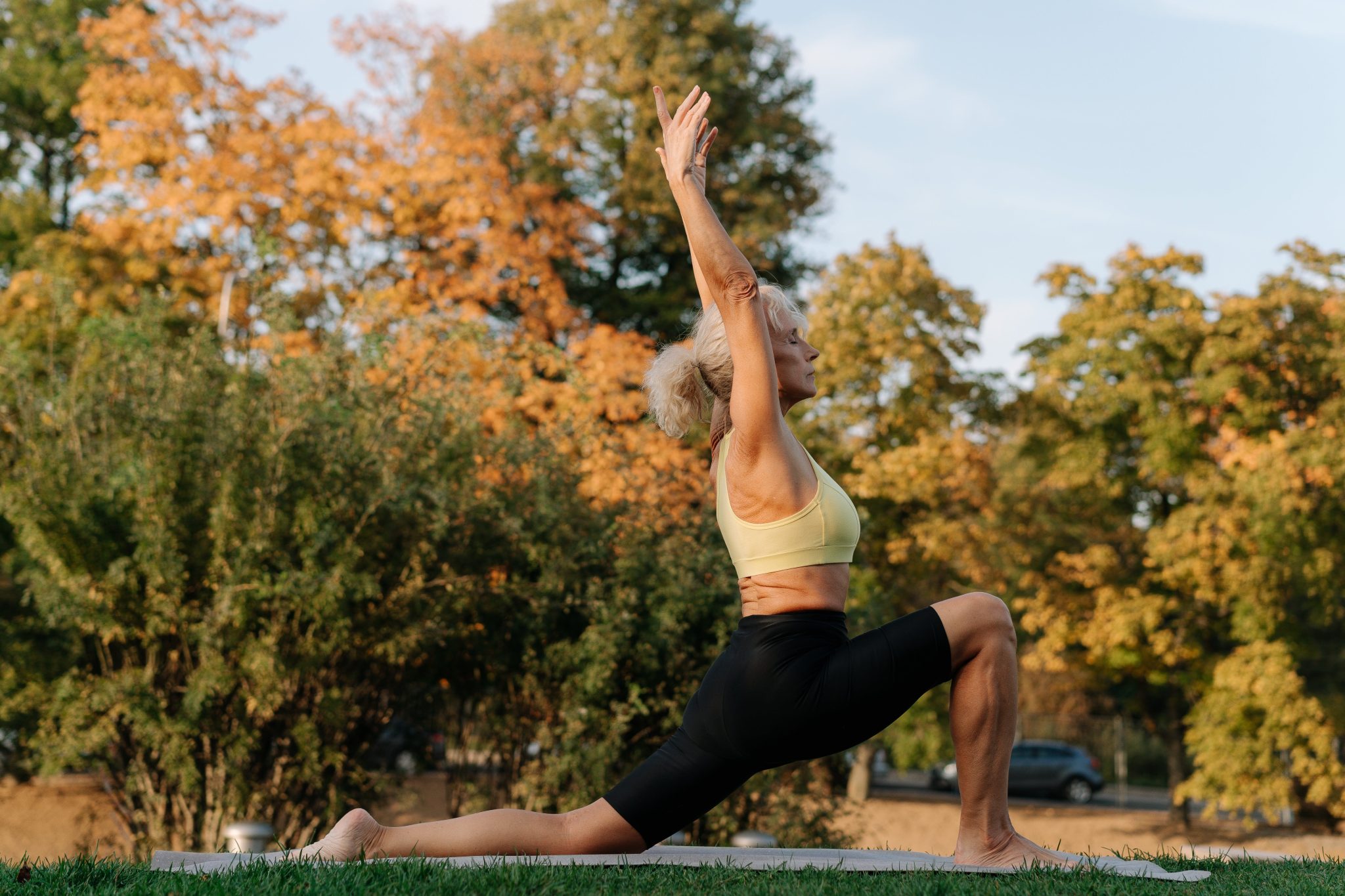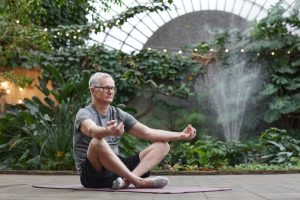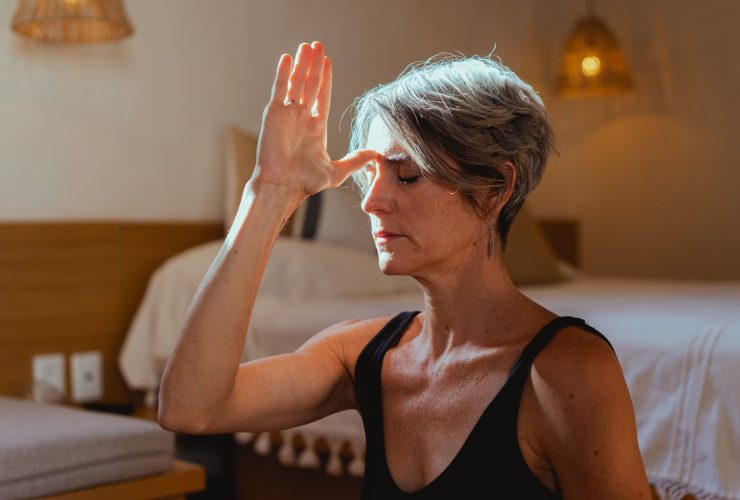While both have been around for quite some time, it’s easy to feel like the terms meditation and mindfulness are big buzzwords these days. It’s hard to pick up a fitness magazine or read an article on wellness without seeing one or a combination of these words.
Unfortunately, despite the numerous benefits of both of these practices, it’s easy for many people to dismiss them without fully understanding what they mean. Lots of people believe that meditation is sitting cross legged in an empty room and trying to completely clear your mind of any thoughts, while maybe humming quietly. And quite often it’s thought that mindfulness is just another name for that meditation.
That’s why today we’re not only going to talk about the differences between the two, but we’re also going to present to you all of the many reasons why these two practices are so helpful for seniors. Sometimes seniors can be reluctant to change their habits. However, if there are practices that could improve your overall quality of life, and boost your mental health, then wouldn’t you want to give it a go?
Meditation
Sometimes, in order to be willing to give something new a try, it can be helpful to understand where it comes from, so let’s dig into a bit of the history of mediation. Research points to the earliest documentation of medication as coming from Vedic texts in India, which would mean that the practice of meditation dates all the way back to around 1500 BCE! In an article in the National Library of Medicine, it is cited that the original purpose of meditation was to connect oneself to one’s deep inner self. Now that doesn’t exactly sound like emptying your mind of all thoughts, does it?
In fact, meditation can be practiced in a number of different ways, and, like with any other activity, it’s important to find the way that works best for you. The following are just a few of the many different ways you could choose to explore meditation:
Transcendental Meditation
Transcendental meditation was developed by someone named Maharishi Mahesh Yogi in the 1950s. He created this type of meditation with the idea of awakening a fourth state of consciousness. It’s practiced in silence, in any comfortable position. You repeat a mantra in your head until you reach a state of total peace and alertness. Many people practice transcendental meditation for around twenty minutes every day.
Chanting Meditation
While many types of meditation don’t involve sound, chanting meditation focuses all of your attention to the sound and vibration of your chant, while also having you focus on the meaning behind the worlds. This focus on one thing can clear the mind while also bringing about a high degree of clarity.
Vipassana
Vipassana is a meditation practice where you silently focus on the sensations of feelings of your body without judgement. It is letting your thoughts come and go without giving any one of them more weight over another.
Yoga
While many people think of yoga as a form of exercise, traditional yoga is actually a spiritual practice that is designed to bring harmony between your mind and your body. There are many different forms of yoga, but all of them focus on something called chakras, which are seen as our major energy centers. It is thought that when an energy center is blocked it can lead to a host of health problems, such as anxiety or digestive issues. Yoga can help release and heal our chakras so we can find balance.
While there are countless other versions of meditation you could try, let’s now move on to what the benefits of meditation are, and how you can slowly start introducing a meditation practice into your life.
One of the biggest positive impacts of meditation are consistent findings that a regular meditation practice appears to improve one’s mental health. We live in a busy world, and it can be easy to become overburdened with social commitments and external stressors. UC Davis Health outlines several benefits of meditation, including its ability to lower anxiety levels. It also has the potential to assist with other mental health disorders such as depression and obsessive compulsive disorder.
But it’s not just your mental health where meditation can make a difference, it’s your physical health as well. Meditation has been shown to improve sleep and digestive health. It can also potentially lower your heart rate and your blood pressure, which can help prevent serious medication events such as heart attacks and strokes.
The Mayo Clinic also points out that meditation can be very helpful for people who are dealing with unimaginably difficult situations, such as chronic pain and cancer. Meditation can help with pain management, and can also help a patient process the difficult emotions that can come along with an upsetting diagnosis.
With all these benefits, you might think that a meditation practice would require a lengthy time commitment, but in fact, you can begin to see some benefits from meditation by practicing for even as little as just a few minutes every day. Of course, the longer you meditate, the more benefits you may see, but for those who are just getting used to the idea of adding meditation into their lives, it can be useful to commit to something small, such as two minutes of focused breathing every morning.
If you’re interested in a more extensive meditation practice, then you might want to seek out a meditation center where an experienced practitioner can help guide you through the practice. Many therapists and mental health counselors may also have good tips for their clients, so if you already see someone then you might ask them for help on developing a practice.
However, if you’re not sure where to turn, or want something that is a littler easier to build into your routine then you might consider using a meditation app. Meditation apps are easy to install onto your phone or tablet, and offer hundreds of different meditation sessions that are targeted towards different issues such as stress, anxiety, grief and sleeping troubles. These can range in length from one minute to over an hour, so you can pick the right fit for you. Some of the sessions are single, while others might guide you through an entire meditation course that takes place over short chunks of time every single day. Many of these apps also offer each session with different voices, so you find a voice that is the most soothing and relaxing for you.
Two very popular options include Calm and Headspace, which both offer affordable subscriptions and a range of guided and unguided mediations so that you can build up your practice in a way that works for you.
So many seniors struggle with the major life transitions that occur as you grow older, and it can be easy to fall into a state of isolation and depression. A simple meditation practice can help pull seniors out of this funk and to face this new chapter of their life with clarity and calm. And with all the other benefits it offers, why wouldn’t you want to try it?
Mindfulness
As mentioned earlier, although they are often talked about in the same breath, mindfulness and meditation aren’t technically the same thing. However, many people do like to practice what is referred to as mindfulness meditation, and almost any form of meditation is bound to increase our mindfulness, so let’s get into exact;y what that means and how it can benefit your life.
Mindfulness is the practice of remaining fully present in the moment. It is being aware of your environment, your surroundings and your response to what is happening without becoming overstimulated or distracted. If you’ve ever told someone to “enjoy the moment” you might have unconsciously been encouraging them to practice mindfulness!
While the idea of mindfulness has been around for more than 2000 years, and likely originates from ancient Buddhist philosophies, it is Jon Kabat-Zinn, a professor from the University of Massachusetts, who is credited with introducing the concept to an audience in the western world. He developed a program known as Mindfulness-Based Stress Reduction, and along with it he has suggested four principles with which to guide your mindfulness practice. There are as follows:
1. Non-judgement
We all make snap judgements, towards others, and perhaps even more often, towards ourselves. This principle is about noticing your pattern of judgement and trying to turn instead into an impartial witness when it comes to your own thoughts.
2. Patience
Changing one’s thought patterns and developing a consistent mindfulness practice takes time. Have patience for yourself. Even once you are more consistent you are going to have some days that are harder than others, so always have grace for yourself.
3. Beginner’s Mind
We live in a world where it’s very tempting to act like we already know everything, and we’re often keen to be experts. Try to remain open to learning, even years into your practice. What a gift it is to always continue to grow.
4. Trust
Have trust in yourself and your thoughts and decisions. Sometimes we operate in the world based on how we think we should be, instead of who we truly are.
5. Non-striving
It’s OK to be content with the present moment. You don’t always need to be reaching towards that next milestone. Mindfulness is about appreciating the present moment and where you are in life right now.
6. Acceptance
It can be difficult to accept an upsetting situation, but we have to acknowledge things as they are. Some things we cannot change, and we won’t be able to move forward until we accept that.
7. Letting Go
Rumination can lead to higher stress levels, and possibly even cognitive decline. Part of mindfulness is learning to let go of thoughts and experiences that no longer serve us.
Just like with meditation, mindfulness has been shown to have many benefits, including lowered stress and anxiety, increased creativity, and an overall improved quality of life.
Mindfulness is particularly helpful for seniors because it is a practice that everyone has already participated in. It doesn’t require any new toolset or a teacher, it’s simply something that someone has to consciously choose to participate in until it becomes a more integrated part of their daily life. Here are a few ways to increase mindfulness in your life:
- Meditation – remember how it was mentioned that mindfulness and meditation are not the same thing, but meditation can lead to mindfulness? Now that’s a mouthful! A daily meditation practice can help us to observe our own thoughts and be more present in our daily life
- Get outside – time in nature is well known for being a stress reducer, and that’s partly because of its ability to make us be more mindful. Sit in a park and breathe. Notice the sounds and smells around you. Observe the shape of the leaves on the trees and how many different plants and animals are in the landscape.
- Slow down – it can be easy to move fast in these modern times, but what’s the rush? Try to plan your day so that you don’t ever need to move too quickly between appointments. Take the time to walk slowly, feel the ground beneath your feet. Look around you at what’s happening, see how other people move through life.
- Put down your device – too often we use devices to distract ourselves. While technology can be a great way to connect with our loved ones and current events, they can also be used to avoid our own thoughts and feelings. Put the device down and allow yourself to feel, maybe to even get bored. What might you do with that feeling?
- Breathe – it might sound silly, but spending time to take even just a few purposeful breaths can be incredibly helpful for increasing our mindfulness. You can do this several times throughout the day, or any time you feel stress creeping up on you.
Most people want to live the best life possible, and the pressure to do so can intensify as we grow older. Meditation and mindfulness can help us age gracefully. Instead of focusing on things we believe we don’t have, these practices can help us be thankful for the wonderful life we’re already living. You might even begin to notice so many positive elements of life that you weren’t aware of before, such as a visitng neighborhood bird, or the beautiful color of the house a few blocks over. In a society that’s constantly telling us that we’re not enough and don’t have enough, wouldn’t it be wonderful to realize we already have everything that we need?









